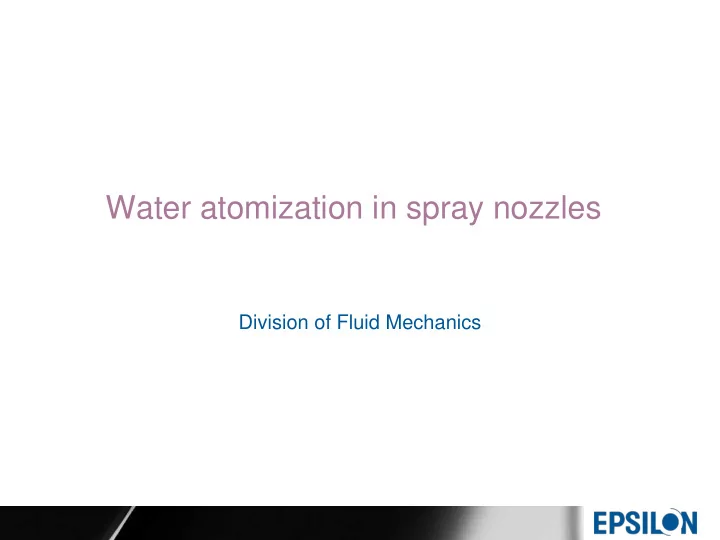

Water atomization in spray nozzles Division of Fluid Mechanics
Contents Introduction Techniques used in STAR-CCM+ Case definition Nozzle description Results Conclusions
General facts about Epsilon 1 500 employees and 10000 independent collaborators and specialists in different networks 23 locations Local development centers A leading supplier of CFD and FEM services in the Nordic countries
Introduction Why study primary atomization? • In STAR-CCM+ the pressure swirl injector present the only choice for primary break up analysis. What about other types of spray nozzles with non conical shape. When modeling sprays you need to have knowledge about droplet and velocity distribution for the specific nozzle in order to set injector properties.
Spray nozzle The water nozzle 1/4MEG1506 Spray data (droplet size) Minimum droplet size: 80 µm Maximum droplet size: 500 µm Mean droplet size: 123 µm Spray nozzle volume
Techniques used in STAR-CCM+ Geometry handling through imported parts for improvìng productivity Trimmed mesh Refinement boxes for resolving the water fluid Imported parts for definition of non regular shapes for reducing the cell count
Techniques used in STAR-CCM+ VOF – model for capturing the interface between the air and water Surface tension modeling Turbulence modeling A number of field functions for spray analysis Thresholds for detailed analysis Histogram plots for analyzing velocity and droplet size distributions
Typical results Velocity The image to the left shows the VOF-interface together with velocity vectors The velocity vectors are posted on the threshold for the water The vectors indicate the velocity distribution and the direction of the velocity
Typical results Velocity The histogram to the left shows the calculated velocity distribution obtained from the VOF-simulation. The data from the histogram will be used for implementing the velocity distribution in the injector of the Lagrangian phase.
Typical results Droplet size The images to the left shows the calculated droplet size in a the VOF threshold after the secondary break up. The droplet size is estimated by using force balances on the VOF-interface. The final droplet diameter is in the range of 90 – 110 microns.
Typical results Droplet size The histogram to the left shows the droplet size distribution for the threshold shown on the previous slide. The mean droplet size corresponds well to the experimental value of 123 microns. The resulting distribution is in the injector definition of the Lagrangian phase.
Conclusions STAR-CCM+ provides an easy to use frame work for analyzing the atomization process. The usage of thresholds, histograms and field function renders the whole process to be carried out within STAR-CCM+. The results are in good agreement with experimental data and show that this method may be used when experimental data is not available.
Room for improvement Under specific conditions or demands on resolution of the VOF-interface an explicit numerical scheme would be desired. Enhance the capability of adding user coding in STAR-CCM+ to the level of STAR-CD. This would improve the capability of adding custom models into STAR-CCM+ without the need of using JAVA.
Recommend
More recommend